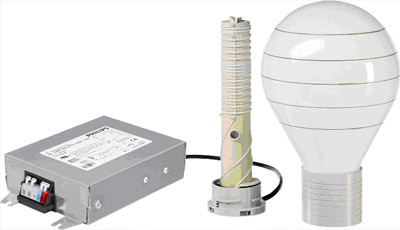10260 E. White Feather Lane
Unit 1013 Scottsdale, AZ 85262
P: 480.513.6170 E: admin@troonlighting.com |
Induction Lighting
How does it Work?

Induction Lighting has been around for over 100 years. It’s proven technology has evolved with recent technology in the electric generator more commonly known as the ballast. Induction lighting works very well in commercial and industrial applications as well as street lighting.
An induction lamp is similar to a fluorescent lamp in that mercury in a gas fill inside the bulb is excited emitting UV radiation that is then converted into visible white light by the phosphor coating on the bulb. In contrast, fluorescent lamps use electrodes inside the bulb to strike the arc and initiate the flow of current. Each time the arc is struck, the electrodes degrade eventually causing the lamp to flicker and ultimately fail.
Induction lamps are different in that they do not use internal electrodes, but instead a high-frequency generator with a power coupler. The generator then produces a radio frequency magnetic field to excite the gas fill.
With no electrodes, the induction lamp lasts longer (as much as 100,000 hours) and produces 70% of its original light output at approximately 60,000 hours. In short, the life is rated 5 to 7 times longer than a metal halide (at 7,500 hours to 20,000 hours at 10 hours/start).
Many people will comment that induction lighting is very bright and as such feel that the quality of light is higher. However, when using a light meter one will learn that the light is less than with a conventional lamp. To this end, induction lighting also uses 50% less energy.
Why is it that our eyes see induction lighting as brighter? The human retina contains 125 million rod cells and 6 million cone cells. These respond to different frequencies (colors and wavelengths) of light in different ways. Cone cells are more sensitive but do not detect color well as they are adapted to low light.
Photopic Vision is the scientific term for human color vision under normal conditions during the day. For example, the human perception of red, green and blue that the brain integrates to form full color images of the world.
Scotopic Vision is the scientific term for human visual perception in low light—night vision.
Mesopic Vision is the scientific term for the combination between Photopic and Scotopic vision taking into account the total sensitivity of the rod cells in the eye for the blue range, with the color perception of the cone cells.
The ratio of Photopic light versus Scotopic light in a lamp is call the S/P ratio. This ratio determines the apparent visual brightness of a light source. This is why a 200W lamp will appear as bright or brighter to the human eye than a sodium vapor or metal halide of twice the wattage.
